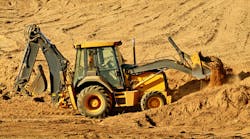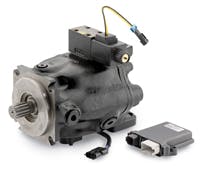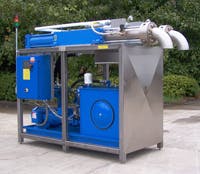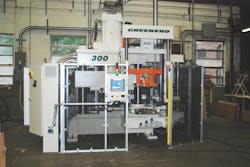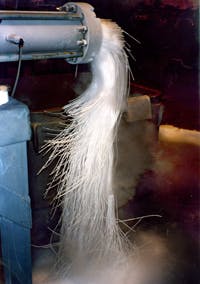Electronic controls boost hydraulic efficiency
Mobile and industrial equipment manufacturers, and their customers, are rapidly embracing a new class of electronic controls for open-circuit, medium-pressure piston pumps like the Parker P1/PD Series. Such circuits are often used where the hydraulics must perform more than one task on the same machine. A backhoe with a loader on one side and excavator on the other is an excellent example. Instead of relying on a bank of valves to manage hydraulic power, all the control can now be handled by software.
This potentially reduces size and weight while permitting smoother motion with higher precision and repeatability. Electronic controls also lead to higher operating efficiencies and usually offer better value than standard load-sense controls. For all these reasons, electronic pump controls are gaining rapid acceptance among OEMs and users.
Here’s a look at how the controls work, and how equipment manufacturers are taking advantage of the benefits in new and retrofit designs.
Traditional load sensing
Pressure compensation, often called load sensing, lets a pump provide full flow at pressures below the compensator setting. When pump flow is restricted, say by a downstream load, pressure builds up to the setting of the compensator; then the pump destrokes (reduces flow) to the level needed to maintain pressure at that setting.
With load-sensing compensation, output flow will increase or decrease to maintain a constant pressure drop (ΔP) across the metering orifice regardless of load conditions. With this arrangement, the pump always waits for system feedback to react and adjust the flow.
This is the basis of today’s traditional open-circuit pumps. The hydraulic circuit reacts to an external load and the pump adjusts flow based on system requirements. Load sensing is generally considered a reliable, proven technology. But they usually can’t match the performance possibilities offered by electronic pump controls.
Electronic controls
Electronic control of hydraulic piston pumps is not new. But the approach, as well as the underlying hardware and software, have significantly changed in recent years, giving OEMs more versatility, superior control, and even options like wireless monitoring.
Early versions mounted the electronic controller on the pump. This required purchasing the pump and controller with all of the supporting electronic cards. The next development moved the electronic cards from the pump to a more appropriate and protected location on the machine, providing mounting flexibility and added durability.
Today’s open-circuit pumps with a programmable electronic-control unit (ECU) often include graphical-user-interface software that lets users quickly set up pump-specific parameters; adjust for machine behavior if needed; set up a data log and monitor pump and wiring status; and calibrate sensors. With these controls, the pump includes the displacement sensor and electronic valves, as well as a pressure sensor, if pressure control is needed.
The pumps are built with either a maximum-displacement default position-control valve for electrical power-loss critical applications, such as fan drives, or with a zero displacement default position control valve which limits flow or pressure for added safety in mobile applications.
Electronically controlled pumps are also available without ECUs. Control logic is then integrated into the machine’s ECU.
Both versions include the directional-proportional valve with optional, but recommended, displacement feedback sensor and hydromechanical pressure limiter.
Thus, electronically controlled pumps are “intelligent” hydraulic components that let OEMs upgrade performance and improve machine operations. For instance, they can reduce fuel consumption and emissions in mobile equipment by supplying the exact amount of hydraulic power when needed, and no more, based on commands from the ECU or inputs from remote sensors. Specific benefits of electronic control include:
Performance. Compared to load-sensing systems, electronic controls are significantly faster in closing the loop on the output flow at the pump. That can equate to better response and higher precision.
Efficiency. Electronic controls improve pump efficiency by reducing control leakage in the pump, compared to a load-sense system. Leaks generate heat. To prevent problems caused by excessive temperatures — such as shortened fluid and seal life — hydraulic fluid must be cooled, requiring a higher-capacity cooling system and a larger fluid reservoir.
Simplified installation. In addition to inlet and outlet lines, typical load-sensing pumps require installing hydraulic load-sense lines to the pump. Electronic control, on the other hand, is a complete package, including the computer. Installing the latter requires less hose, fewer fittings, and less manpower.
Tamperproof. Because there is no adjustment screw, as with load-sense units, electronically controlled pumps are essentially tamperproof. Once set up, the software defines the system.
Typical applications
Open-circuit pumps with programmable ECUs are used for such basic functions as proportional flow control, flow and pressure control, and overcenter operation (where flow direction is reversible) for energy-recovery applications.
In simplified terms, anything that can be electronically controlled can take advantage of these systems. A few examples include hydraulic fan drives, booms and lift arms, and industrial presses. Machines that require two separate hydraulic functions that are completely different in terms of performance and horsepower management, such as the previously mentioned backhoe loader, are good candidates for these systems. And the pump’s overcenter capability paired with electronic control can be used for energy recovery. In oilfield applications, they’ve proven to save large amounts of electricity (or fuel) when extracting oil with hydraulic rod pumps.
Cost versus value
In a straight cost comparison between electronic-controlled pumps and traditional load-sense pumps, the latter will win outright. But more important than looking at purchase price, however, is evaluating the total system cost.
For example, electronically controlled pumps come as a complete unit. With load-sense pumps, on the other hand, additional components like proportional valves cost extra. And, as mentioned earlier, load-sense pumps require extra hoses and fittings that add to assembly and setup time, as well as costs.
For any system, the real question centers on productivity and overall economics. With electronically controlled units, for instance, how many hours are saved by running faster? What is gained thanks to better precision? And what are the savings due to higher efficiency, lower operating temperature, simplified installation, and wireless monitoring and reporting? Two applications that document the value electronic control brings, a press and a dry-ice extruder, are detailed in the accompanying sidebars.
300-ton press
Engineers at Greenerd Press and Machine, Nashua, N. H., streamlined a press that compression molds carbon-fiber composite panels. Hydraulics controls the closing speed of the press, as well as the tonnage (applied force), and the process demands precision and repeatability in both tooling motion and force levels.
In the original design, the main platen on the 300-ton finishing press would close and hot-form a part at a specific tonnage, dwell time, and decompression rate. The previous hydraulic circuit incorporated a proportional directional-control valve, as well as a proportional-relief valve. The relief valve usually controlled the variable-volume pump’s compensator setting, unless pump response was deemed too slow for the application. In such instances, a large full-flow proportional system was used to chop off pressure spikes and prevent overpressurization at differing tonnages, to protect tooling from damage.
To simplify the press, the redesign incorporated a Parker PD axial-piston pump with an ECU. The ECU’s P/Q capabilities (the ability to simultaneously manage pressure and flow) made the press more intuitive to program in terms of recipe management for different panel shapes and profiles. And the unit’s graphical-user-interface software made tuning straightforward, according to Greenerd officials.
The press cylinder incorporated a linear-feedback transducer, and lookup tables stored in the machine’s PLC controlled closing speed in an open-loop fashion. Because pump output is extremely repeatable, the correlation between the indexing table and actual speed was also repeatable. This eliminated the need for more-cumbersome closed-loop feedback within the PLC, while still yielding results that mimic closed-loop speed control.
The end result was a smooth-acting, highly repeatable press. P/Q electronic control more than paid for itself by simplifying the design and eliminating components, while increasing throughput. It also cut operating costs by reducing the number of components that had to be maintained.
Dry-ice pelletizers
Dry-ice pelletizers made by Tomco2 Systems, Loganville, Ga., rely on variable-speed hydraulics to turn CO2 “snow” into hard, uniform pellets. First, loose, dry-ice powder is injected into a chamber inside the pelletizer. Next, a hydraulic cylinder strokes at high speed to compress the snow to a suitable density for extrusion. The pump then destrokes to minimum flow, reducing cylinder speed for extrusion.
Dry ice is extruded through the die at low speeds to tightly control quality and reduce the horsepower required to produce pellets. When the extrusion stroke completes, hydraulic valves shift to retract the cylinder at high-speed (full pump flow) back to the home position.
The operating environment is extremely harsh. Dry ice is processed at –109.3°F, and moisture builds up during machine operation, forming ice on steel components. In a previous version of the machine, the hydraulic pump had a minimum volume stop and a compensator control block that mechanically shifted from high to low speed as extrusion began.
The new pump had to at least match the performance of the previous unit, operating at both partial and full flow, at pressures to 3,000 psi, and 24/7. Tomco2 engineers opted for Parker’s PD pumps with electronic control for this open-circuit application. The new pump boosts efficiency through horsepower control by tightly managing both pump flow and pressure.
During the extrusion process, the working pressure starts high and, as the extrusion of dry ice begins, pressure tapers off. The electronic control monitors and adjusts extrusion speed based on load resistance. In turn, this let the company decrease overall cycle time and produce a more-consistent extrusion.
In addition to a slightly faster production cycle, the company also improved process efficiency and product consistency. Electronic controls also made it possible to eliminate two pressure-reducing valves along with a valve that controlled pump decompression. Now, software handles decompression.
